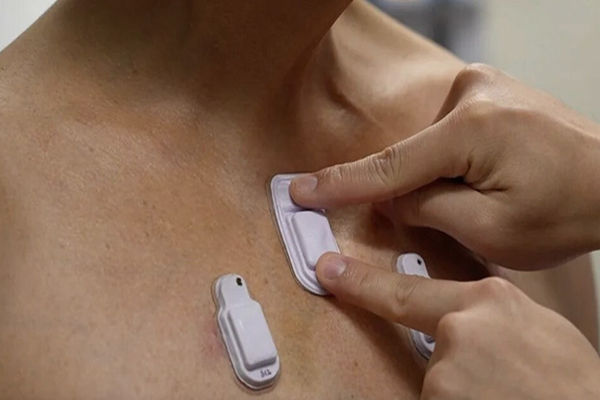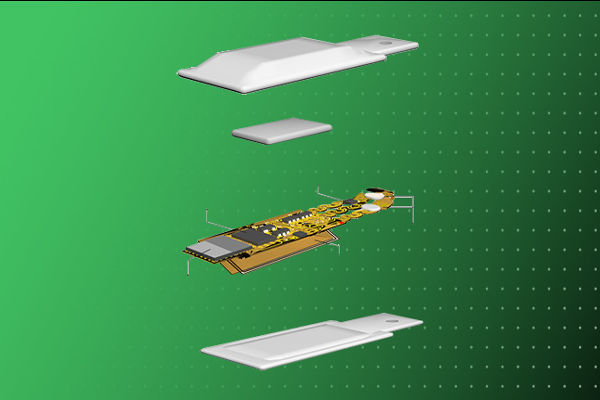The stethoscope’s development in the 19th century lead to ultrasound, photoacoustic imaging and microscopy. These techniques enable detailed visualization of organs and tissues.

However, they are still generally limited to a single point in time. Unless a patient is connected to often complex or cumbersome equipment, they cannot usually be used for continuous, long-term monitoring.
Research continues into wearable monitoring devices. The goal is to provide reliable, detailed and accurate data that can be analyzed in real-time when necessary.
The key benefits of continuous monitoring using a wearable device include the early diagnosis of diseases, the study of intermittent problems, and understanding the environment in which such problems occur. The ability to monitor a patient and/or medical data from a distance is a huge benefit for medical professionals.
Anyone undergoing 24-hour heart rate monitoring with a Holter device will comprehend the need for improvement. The process involves being wired up to a battery-operated system with multiple sensors attached to the chest.
The accuracy and reliability of consumer solutions, such as smartwatches or chest-strap heart rate monitors, are good for fitness enthusiasts but are less useful in detecting potential disorders.
Making medical monitoring mobile
Above all, the next generation of medical-grade, wearable monitoring devices needs to be wireless. In addition, devices must be small, comfortable and lightweight as well as robust, easy to handle, low power and able to either record data or transmit it wirelessly to a base station. Additional features such as wireless battery recharging and programmability extend the application arena.
Acoustic technology for continuous health monitoring is developing swiftly and will prove efficacious in a wide range of medical applications. These include cardiac monitoring, fetal monitoring, examining bowel and gastrointestinal sounds, and respiratory analysis to detect sleep disorders, pneumonia, asthma and even COVID-19.
Diagnosing these conditions should no longer be time and resource-consuming, uncomfortable or involve invasive procedures. Wireless acoustic wearables will be a significant advancement, particularly for monitoring bowel and intestinal disorders.
Wearable and wireless acoustic sensors

MEMS devices as acousto-mechanical sensors
MEMS (microelectromechanical systems) sensors are proven in medical and health monitoring applications. New kinds of MEMS sensors are the focus of research projects worldwide, with more advanced, smaller devices emerging.
Typical MEMS sensors include microphones, accelerometers and gyroscopes, as well as devices for measuring pressure, gas, heat and flow. They are already used in a wide range of healthcare products including hearing aids, blood pressure monitors, glucose monitoring, heart rate monitors and pacemakers.
These miniaturized complex components are becoming critical. They are the only solution to making accurate and reliable measurements using small, wearable devices. MEMS are unique in the identification of the vibrational content of acoustic signals. The sensors generate electrical signals from various environmental signals. In acoustic medical applications, the most relevant methods use displacement to detect velocity, acceleration, acoustic wavelength and acoustic intensity. MEMS can also be used in chemical, thermal, radiative and magnetic applications.
Acoustic sensors respond to sound waves propagating through air, liquid or a solid. Combined with other sensors, such as inertial, RF, force, thermal and chemical, a MEMS sensor system creates a holistic approach to precise monitoring.
MEMS sensors typically have good mechanical and electrical properties, low power consumption, high sensitivity, high resolution, stable performance and, crucially, they are small. Easy integration with other devices is vital, especially for storing, processing and transmitting data.
Acousto-mechanical sensors in healthcare
Researchers are developing a broadband, acousto-mechanical sensing network that can be incorporated into small, soft wearable modules. Tests have proven the clinical-grade accuracy of these devices and their resilience to artifacts from ambient sounds.
Inside a wearable sensor

The research includes monitoring slow movements within the body, digestive activity, respiratory airflow and cardiac rhythm. The researchers claim the technology will help mitigate cardiorespiratory instability and manage disease progression through continuous monitoring of physiological signals in both clinical and non-clinical settings.
The devices contain pairs of high-performance digital microphones and accelerometers encapsulated in a soft silicone material. Measuring 40 x 20 x 8 mm, the sensor network also incorporates a flash memory drive, battery, Bluetooth capability and additional componentry.
The use of two microphones enables the system to capture and separate external and internal signals. The external noise can be useful in providing contextual information on the patient’s surroundings. The devices are expected to be particularly helpful in fetus and premature baby monitoring.
A European consortium coordinated by Infineon Technology Austria, called Listen2Future, is boosting the potential of piezoelectric acoustic transducers. The research includes miniaturized MEMS microphones and piezoelectric ultrasonic transducers based on flexible thin-film materials. Projects include wearable ultrasound patches for early detection of heart disease. Work is ongoing across the ecosystem covering materials, design, signal processing, assembly and packaging, as well as software and artificial intelligence algorithms.
Other research into the development of electro-acoustic technologies is also beginning to yield real potential in clinical applications. Although not yet in the domain of wearables, the work demonstrates the promise of the technology. Briefly, from an article in Nature, four application areas are emerging.
Acoustic mechanobiology studies the role of mechanotransduction in touch, pain, hearing, blood flow, flow sensing in the kidney, and embryonic development using focused ultrasound.
Acoustic “tweezers” deliver acoustofluidic point-of-care diagnostics such that tumor cells can be separated from white blood cells, for example. Ultimately ultrasound excitation could be used to pinpoint and potentially destroy the SARS-CoV-2 virus. Currently, however, extensive external equipment is required.
Acoustic technologies for 3D tissue engineering are at an early research stage. Stem cells can be acoustically aligned, for example, and acoustic holography is one approach for fabricating complex tissue structures.
Acoustic technologies for in-vitro and in-vivo manipulation using acoustic vortex-based tweezers have the potential to move kidney stones and deliver drugs to a targeted spot.
Smartphones and tablets in healthcare
While fitness devices may not be designed for accurate health monitoring, modern smartphones incorporate sophisticated sensors that can be used for certain monitoring applications.
A mobile device, such as a smartphone or tablet incorporating two microphones, has been shown to generate an acoustic cardiogram from inaudible acoustic signals. By using frequency-modulated sound signals, the solution can discriminate the heart data from external noise, converting acoustic data into heart and breath rates. It is also effective in monitoring and recording audible respiratory data from a sleeping patient.
A smartphone or other smart device can also function as a base station receiving data from a wearable device. The user or an app can then easily forward the data via the cloud to medical professionals as necessary.
Wearable medical devices growth
Estimates of the global market for wearable medical devices vary, from around $20 billion to $30 billion in 2022 rising to $60 billion-plus by 2026, depending on whether fitness devices are included. However, all market research companies agree that the market is growing and will continue to do so for the next decade, probably around 15-25% compound annual growth rate.
For medical monitoring and diagnostics, the key drivers are the aging population, the prevalence of chronic diseases, and the trend towards home healthcare post-pandemic.
Once proven, next-generation acoustic technology will be commercialized. Given the potential, there is likely to be significant global demand for these new devices. Opportunities abound for proactive OEMs, as solutions will need packaging together with intelligent signal processing, software/algorithms, data storage, power/power management, and wireless communication capability.
While some products may remain in the clinical domain, as results need expert interpretation, some are likely to become home-centered healthcare products, much as blood pressure, glucose and heart rate monitors are today.
The doctor’s stethoscope won’t be obsoleted any time soon. But the range of affordable, wearable options is growing.
Article Source: https://www.avnet.com/



